Interview: Jan Troell
Swedish director Jan Troell, 84, is an outdoor poet, an expansive humanist, and an intuitive psychologist. In movies like Here Is Your Life (66), The Emigrants (71), The New Land (72), and The Flight of the Eagle (82), his ecstasy for the physical world merges with his love for his characters. The vital, sensual heroes and heroines in these classic Swedish movies emit an illumination that emerges from within and enriches Troell’s enveloping auras of sun, rain, ice, and snow. Even in conventional urban settings and interiors, Troell can ignite explosions of beauty and insight, like a brightly lit electric streetcar slicing through a city snowfall and bringing dazzle to a depressed atmosphere in Everlasting Moments (08), his late masterpiece about a working-class mother and photographer. In his trenchant The Last Sentence (12), the friend of a crusading anti-Nazi editor confesses that he’s dying of pancreatic cancer, then shuts off the lights in his mansion, one by one, with an elegant finality. You think of Sir Edward Grey saying before World War I: “The lamps are going out all over Europe; we shall not see them lit again in our lifetime.”
Troell’s ability to write, shoot, and edit as well as direct gives his movies an exploratory dynamism and freedom all their own. As the gorgeous uncut Criterion editions of The Emigrants and The New Land illustrate, he can be the most democratic of moviemakers. He captures the diversity of individual reactions to common experiences as he chronicles a mini-migration from the province of Smaland to Minnesota. He follows two main groups: the family of farmer Karl Oskar (Max von Sydow) and Kristina (Liv Ullman), including Karl Oskar’s brother Robert (Eddie Axberg), and the household and religious cell of a lay preacher, Danjel (Allan Edwall), Kristina’s uncle.
Troell portrays Swedish provincial life as a test for proud people. The land is rocky and infertile. The weather is capricious. The society is a few steps up from feudal. Karl Oskar’s father is crippled when a boulder he is clearing from a field falls on him. (In one of the movie’s first piercing images, his stolid country wife lugs him home on her back.) Robert daydreams on the job while working as a farmhand and his employer cruelly boxes his ear, damaging it for life. The church forbids Danjel to conduct his own services with followers like an outspoken ex-prostitute, Ulrika (Monika Zetterlund).
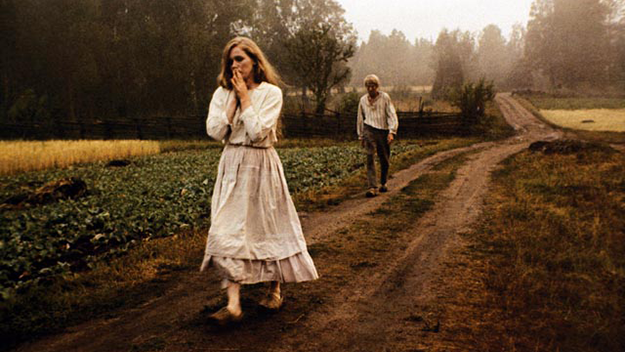
The Emigrants
The director creates his own everlasting moments, and they’re often joyous. Kristina stands up on a swing and sways with abandon when Karl-Oscar comes to court her. Robert, thrilled by a book about the natural sciences, floats his cap and his clogs down a stream to check out the fluidity of water. During their voyage to America, Troell balances terror and delight. He depicts an entire storm from inside the leaky hold where the sickened, frightened Swedes are bunked. That crucible makes it all the more rapturous when sunrays once again streak across the billowing sails.
In a peak of celebratory moviemaking, Karl Oskar hews his way through a dense, green Minnesota forest until he reaches the farmland of his wildest fantasies. Then he chips his name and nationality into the bark of a tree. That’s when he allows himself to rest, smiling proudly as he lets his hat drop over his eyes. For him and for us, it’s a supremely satisfying moment.
The emigrants encounter fresh wonders and horrors as they establish homes and a new community. The dreamer Robert and his thick-headed, good-hearted buddy Arvid (Pierre Linstedt) head out to California in search of gold. Troell renders the ensuing disaster in flashbacks with editing, shooting, and scoring so innovative and expressive it’s as if Troell is filtering the action through Robert’s broken psyche. As Kristina strives to overcome her homesickness, pregnancy becomes a health crisis.
The Swedes face the fact that the land they bought from the government was originally seized from Indians, who, out of hunger and rage, commit awful atrocities and receive terrible punishment. But Troell still doesn’t undercut the emigrants’ achievements. By his final scenes, Karl Oskar comes off as an indelible part of the once-alien environment where he raised his children and buried his wife. The Emigrants and The New Land allow audiences to question every aspect of the American experience without draining it of valor and decency.
Note: Troell now lives in Smygehamn, at the most southern point of Sweden. I interviewed him by Skype three weeks ago at his daughter Yohanna Troell’s apartment. She lives in Malmo, a few blocks from the school where he taught elementary school students “everything.” She helped prod his memory and clarify his English. 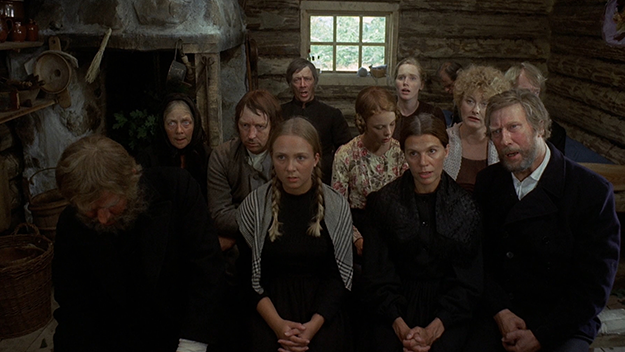
The New Land
How long were you a teacher?
Oh, that was a long time ago, in the 1950s and early 1960s. I became a teacher because I didn’t know what I wanted to be, actually. I started still photography as an amateur, when I was 14. Then I borrowed a 16mm camera to do a film for my pupils about my hometown, Malmo. It was about 20 minutes long, and was shown on TV two years later. It was half-documentary, half-fictional—well, maybe more a documentary. I used one of my pupils as an actor. It was about one young boy walking around, looking for his turtle—it had gone astray in the town. The point was to interest my students a little more in their subjects! It was important to me that it was shown on television in 1958. Television in Sweden had just started, really. They needed films; it was not difficult to get a short film on television.
What subject matter did you teach?
Everything, maybe nothing! [Laughter] As an elementary school teacher, I taught every subject from gymnastics to chemistry. I ended up nearly blowing up the whole school making an experiment. When I was showing them how to produce hydrogen gas, it became another gas, and there was such a big bang that it was heard throughout the school. So—I finished my teaching a short time after that.
Did your early film education come from watching movies on TV?
No, I bought my first television in 1960. I read one or two books about film. One was about editing. After this 16mm film which I edited, with no real editing table, I just spliced these bits and pieces and looked at each version. It was very amateurish, but it was not so bad of its sort! Then I bought my own 8mm camera and used that for some short films too. It took till 1964 for me to get the opportunity to make my first professional film. I didn’t go to any film school. I went to a lot of movies.
I quit teaching after about nine years. My first short documentaries got me the chance to work professionally. I went to Stockholm, which is about 600 km from Malmo—where I lived—by train, carrying a box filled with three or four short films. Then I went door to door, asking different film producers to look at what I had done. I remember the first company I went to was Svensk Film Industry, the biggest, where Ingmar Bergman made his films. When I told them what I wanted to make next, they said, “We’re sorry, we already have too many short films.” They didn’t even look at them. But by my third producer, I found someone interested. One of my ideas was a horror film for children: a little girl has a nightmare of being locked up in a windmill. I had made it without sound, and I needed a producer so I could add the sound and blow it up to 35mm. For some reason, Ingmar Bergman looked at the film—I didn’t know it at the time—and I heard later that he liked it very much. And so did the producer Bengt Forslund—I worked with him for most of my feature films. He was the one who asked me to do a 30-minute short feature with Max von Sydow playing the leading part—Stopover in the Marshland [65]—and then my first long feature, Here Is Your Life, that was also recently published by Criterion. Stopover in the Marshland was based on a short story by the Swedish writer Eyvind Johnson. He got the Nobel Prize in the early ’70s, and he wrote Here Is Your Life, part of a four-part novel that is more or less autobiographical. From those days on, whenever I’ve based a film on literature, I want the feeling of it to be similar to what I’ve experienced reading the book [I’m adapting].
Both Stopover in the Marshland and Here Is Your Life take place in northern Sweden. The landscape and the nature have always meant a lot to me—that was actually the first source of inspiration for my films. And I liked the music for the short film so much that I insisted on the composer, Erik Nordgren, using the same theme in Here Is Your Life. He resisted at first, but he made a variation on it, using an accordion and flute! At the time, Max von Sydow was working in Hollywood. He was finishing The Greatest Story Ever Told, playing Jesus, and he had a contract to do a Western [The Reward] directed by a French director [Serge Bourguignon]. We had a contract with Max to do our film. There was a date when we were supposed to start, and if they went over time they would have to pay us. The Hollywood film did pay us a fine—and that amount of money was more than was needed to produce our film.
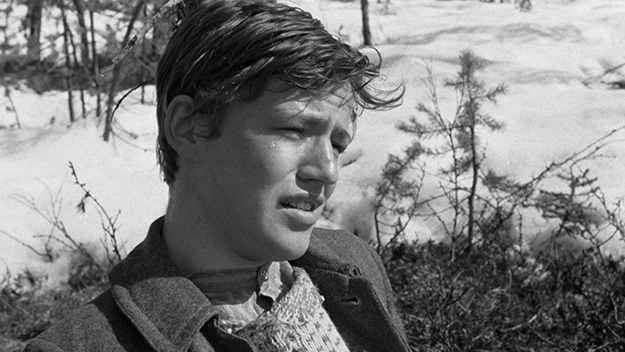
Here Is Your Life
Yohanna just said that the producer was impressed with how you directed Max von Sydow, and how gutsy you were with him.
Max and I have always had rapport. I had never worked with actors before. I was nervous to do that. And Max gave me such confidence by the way he helped us. We were a very small team, working 10 days. Everyone had to contribute to the work, carrying things, and Max did the very same thing. He became a sort of mentor for me—he taught me some practical things about filmmaking, how to solve the problems.
When did you work with Bo Widerberg? We now know him mostly for Elvira Madigan.
That was before Stopover in the Marshland. I read an article Bo wrote about an area of Malmo in the local newspaper. A producer at Malmo Television got the idea that it would be nice if we met and were inspired to do a film together. We did do a short film together [Pojken och draken, 62]. I then had a 16mm Bolex camera; we didn’t shoot any synchronized sound. When the film was shown on television later, another critic ended his review saying, “These two gentlemen threaten to come back.” Later, when he did his first feature, The Pram [63], he directed and wrote the script, and I was the cinematographer. We were really both amateurs. We both learned something from it, and it was quite well received.
Widerberg declared himself independent from Ingmar Bergman, saying that he made films that were more outward-looking and social or political than Bergman’s.
That’s quite true… I think many directors in our generation were in opposition to Ingmar Bergman. I never was because his films inspired me. And Bergman himself—he supported me. There was a film I wanted to make and no one wanted to produce it, and he just pushed some buttons and a producer said he wanted to do that film. The film was Bang! [77].
You never made that kind of statement, though your films, too, are always rooted in a social fabric. You maintained your distance just by being yourself.
Yes, that’s one way of seeing it. I think that’s quite true.
Even the most technically polished actors in Here Is Your Life, including members of Bergman’s stock company like von Sydow, Gunnar Björnstrand, and Allan Edwall, seem to be spontaneously inventive. Was there an exuberance and joy in the making of that film?
It turned out very well but it started scary. After trying to shoot the first dialogue scene, on one of the first days, I felt the pressure from all the people standing behind the camera—we were not so big a team, but it was so different from what I was used to. I had a camera on a tripod—I was the camera operator, too, but I just got paralyzed! I think it was the impatience I felt behind me. I felt the pressure of the Ingmar Bergman myth of the director. I just felt, “I can’t do this!” The dialogue didn’t sound right. The actors didn’t come alive, and I didn’t know what to do to change it. So we had to break and go home without anything that we could use. During the following night I seriously considered running away from all of it: I realized I’d come to the wrong place! That’s when the producer, Bengst Forslund, helped me by telling me, “You should do it your way.” It was during the night but we were shooting daylight: in Northern Sweden there’s no night in the summer, and the most beautiful light is during nighttime. “Do the scene your way with a handheld camera, no sound, don’t think about any dialogue, just shoot it.” We had no team—just my assistant, the actors, and Bengt. Bengt gave me confidence, and I got it. After that it went much easier. That scene actually, I think, became the best sequence in the film. It’s when the young boy (Eddie Axberg) is teaching the girl (Signe Stade) to ride a bike. Yes, I loved the shooting later on. Also, in every shooting of every film, there are moments when I feel I’d rather not be on that film on that location at that moment.
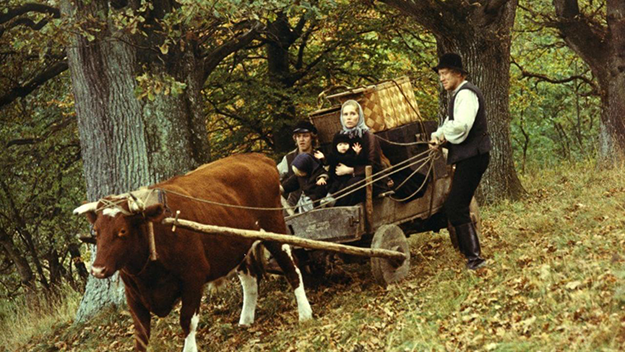
The New Land
Were you intrigued by the history of America before you made The Emigrants and The New Land?
I had seen all those American films about the West, and as a boy, read all the books about cowboys and Indians. It was a subject that fascinated me. When I was asked to direct the film based on Vilhelm Moberg’s four novels, I was very hesitant. I was one of the very few Swedes that hadn’t read them. But then I read and loved the books, and that’s one reason I was inclined to say, “Sorry, I can’t do it.” The books were so complete in themselves as well as being the most well-read novels in Sweden. Each reader had his or her own image of them. I had to work myself into it. I couldn’t immediately find what I could contribute to them.
They also make up a big epic work, and that’s never been close to my way of making films, though I love to watch epics. Not until I found a lyrical approach to the contents did I suddenly think, “This is right.” It was like the moment in Here Is Your Life when I discovered the way I wanted to work and it changed everything. One detail in Moberg’s books gave me the feeling, “Yes, I can find my own way.” It was a few sentences in the third novel where the author writes about how Kristina was always missing her own country, longing for it. She remembers her dearest toy, a doll she had when she was a child—a porcelain doll in a blue dress. And when she dropped it in a well, she could still see it at the bottom, in the water. After she came to America, the doll became more and more beautiful in her memory. This image of a blue doll under the water—it just spoke to me and fascinated me. I started reading the books in a different way. This scene was written in the script, but I never shot it.
I had a name for that when I was teaching chemistry—that scene worked as a “catalyst,” the thing that causes a chemical reaction but doesn’t take part in it.
Moberg himself chose you, correct?
Vilhelm Moberg was very good friends with Eyvind Johnson. Moberg had seen Here Is Your Life and liked very much the way it had been done. Several times, Swedish producers and others had tried to buy the rights to his books, but he turned them down. I heard John Ford wanted to film the books, but Moberg turned him down.
Was it that he felt you could handle the material or did he respond to your use of natural light and the visual freedom of your moviemaking?
We never talked about it. But I guess that he liked the natural feeling and the way the actors come alive. I’ll tell you who was very important for those two films—the production designer, Per Lundgren [P.A. Lundgren], who had worked for Ingmar Bergman on several of his films [including The Seventh Seal and The Magician]. He grew up as a farmhand, so he knew every aspect of the kind of life these people led. He instructed von Sydow on how the farmers really worked, and, thanks to him, everything was thoroughly detailed.
Two days ago I saw the first part [The Emigrants] at the Gothenburg Film Festival, where they were showing both parts. It’s become quite timely again because of the refugee crisis. It’s been a long time since I watched it, and I stayed awake! That was astonishing to me. [Laughter] One thing I thought about as I watched it was how little dialogue there was. The Emigrants was based on two of the novels—a lot of pages, and a lot of dialogue. We tried to express as much as possible with images. Many things that a film would normally put into words, we put into images to tell the story. The dialogue we did use was 90 percent directly from the books.
Not just the dialogue, but even the explanatory titles come from the novels—I love the way you hand us the information about Karl-Oscar’s parish from the beginning, the way Moberg summarizes the sociological makeup, including the number of whores, thieves, and idiots.
The movies would have been twice as long if we tried to get all that material into scenes, but we did think it was important for audiences to know a little background. Watching the movie again, I thought that if this had been made in Hollywood, the same subject with the same story, it would have looked very, very different. So maybe that’s why it surprised people and they liked it so much.
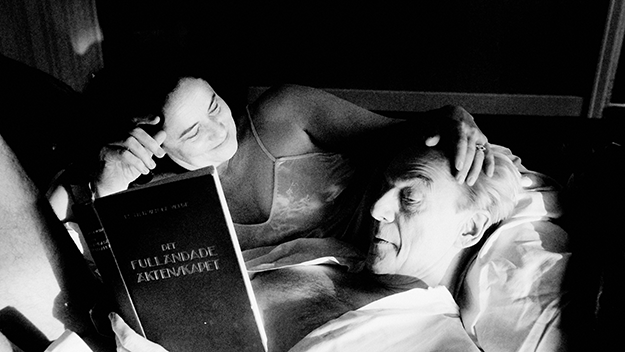
The Last Sentence
Even when you celebrate the heroism of the emigrants and their Homeric travels, you illuminate their limitations and flaws as people, just as you do in your films about celebrated and sometimes controversial characters like the explorer S.A. Andrée in The Flight of the Eagle, Knut Hamsun in Hamsun (96), and most recently, Torgny Segerstedt in The Last Sentence.
It’s instinctive, I guess. I’ve never been interested in idealizing people. I look more to the negative than to the positive. [At Yohanna’s prodding in Swedish]: I’m not too interested in heroes.
After working for Bergman, did von Sydow and Ullman feel relief playing a normal married couple?
I am sure they did. Liv Ullmann has in many interviews mentioned that Kristina was her favorite part in any film.
Your unconventional shooting draws surprises from your performers. Your camera is always roaming and picking up subtle shifts in posture and expression. When Ullman is on the swing, you draw us into her motion and emotion. You create a memory so strong that the audience feels it as poignantly and intensely as von Sydow does when he recalls their courtship near the end of The New Land. You seem to be in the business of creating memories from vivid present-tense action: it made perfect sense to me that you went on to make a great movie called Everlasting Moments.
When I saw The Emigrants two days ago, watching her in the swing, I thought that today I would have cut that part by a half or a quarter, and all that zooming made me feel a little bit embarrassed watching it. But at the same time, Liv is so alive there, her acting is so fantastic, I guess that’s why I kept all of it in.
Terrence Malick has become famous, or notorious, for doing something that I’ve heard you do: if something outside of the script catches his eye during the shooting of a scene, like a cloud formation or a bird, he’ll shift his camera over and catch it. Eddie Axberg has joked that when he acts for you he’s relieved, because he knows that if his performance isn’t working, there’ll always be something else to see!
One reason for me to operate the camera myself is that I can improvise the movements of the camera around things that I didn’t plan, if I see something, somewhere, beyond the frame, with my other eye. That can be very irritating for the actors, I guess, because they can go on acting and acting when the camera is no longer on them. I can understand that. But no one ever complained about it. Well, Gene Hackman got upset one day when I did it on Zandy’s Bride [74]; he was not used to that.
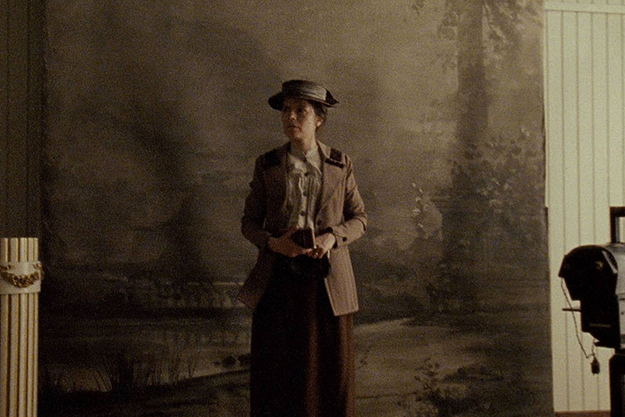
Everlasting Moments
The big challenge for you must be keeping the whole movie in mind when you’re picking up these details, whether you’re shooting a close-up of a steamboat paddle or of a woman’s hands kneading dough. Is your goal simply to get as much richness as you can out of each environment to increase your possibilities in the editing room?
For me, getting the sense of where I shoot is very important, but so is getting as close to what I want for the script as I can, then and there. Usually I prefer shooting on location to shooting in a studio, where everything has to be planned in detail. Because, for good or for bad, things suddenly happen when you shoot on location, and that’s fascinating—if it’s possible to use!
When you were watching The Emigrants again, were there moments when you thought, “Wow, I was so lucky!”
Yes, definitely. Maybe this was the first time I was rather happy with the film. Because when I’ve seen the film together with an audience during all these years, and I’ve done that several times, I felt each time, “This is too long; I should have cut it.” But for some reason I didn’t think that this time. I think that’s because suddenly I became aware that it really had a sort of documentary feeling, although this story happened 150 years ago. As I said, that is partly because of the designer and the actors, but also because I started out making documentaries and they taught me how much you can pick up with the camera. I love details. And sometimes I don’t feel as free shooting a film today as I did with those films. In a sense, the more you know about the work and how to do it, the less free you feel, and that’s not good. You lose a sort of naïve feeling.
Really? You continue to surprise me. Everlasting Moments is full of unforced poetry, like the moment when the narrator, the heroine’s oldest daughter, eyes a boy through the water-soaked glass in a fish market. It’s like a funhouse mirror of first rapture. And you keep seeking the unusual incident in biography or history that’s both telling and dramatic: in The Last Sentence, the heroic anti-Nazi newspaper editor rides into his farewell party on a mock horse, with a lance.
That horse was just thought out for the film. But we did very thorough research about Torgny Segerstedt. We had two biographical books and a lot of letters and newspaper articles and so on, and people who had known him and could talk about him. So what we wanted to do was come as close as we could to this character, but you have to use your freedom—your poetic license.
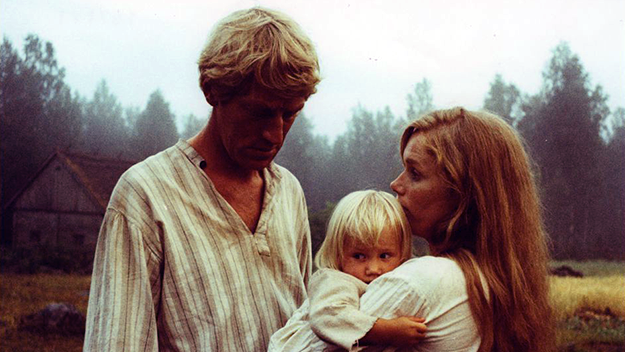
The Emigrants
The Emigrants and The New Land are full of contrasts in imagery and rhythm. I’m thinking especially of Robert and Arvid’s fateful quest for gold in California, which is rendered in these highly experimental, impressionistic flashbacks, a very eerie use of syncopation on the sound track, and, at one point, images that seem to collapse in on each other. Were any of these concepts in the script?
I don’t think anything like that was planned in the script. When the producer and I wrote the script together, it was not as long as the films turned out to be; we thought we had two normal-length feature films. When we shot the films, we did both at the same time. And in some cases, during one day, we shot scenes for The Emigrants before noon, and then in the afternoon, we shot scenes from The New Land. The scene you point out, when Robert and Arvid, the two young boys, are going to California, through the desert—I got the idea for that special editing of the desert scenes while I was editing. I actually took three frames from one scene and then cut in, with a tape splice, three frames of another, so you had two scenes running in time without superimposing them. That effect happened in the eye: you get a somewhat different feeling than you would have if they were simply superimposed.
Think of Scene A and Scene B or Image A and Image B. To create a feeling of fever and drama and danger when they’re walking in the desert, I just got the idea I wanted to mix these two scenes, A and B, but not superimpose them—use two, three, or four frames from A and the same amount from B, with a lot of splicing, not done in the lab. The difference is that the eye gets those two things so rapidly, because I only use two, three or four frames each. You get a very special rhythm. Today that would have been easily done with digital editing, but I’m not sure it would have the same effect.
When I was editing, my close friend Georg Oddner watched a cut of that scene, and, while sitting at the edge of the table, started pounding with his fingers—he very often did that, because he was a jazz drummer. I was fascinated by how that pounding added something. I told him, “You have to do the music for those spots in Robert’s flashback dreams.” We put him in a dubbing studio with a drum set and he just improvised while watching the film, and I did the final edit afterwards.
Alejandro González Iñárritu must know your movies. In Birdman, the whole score is done with a drum. In The Revenant, there’s a big scene where Leonardo DiCaprio cuts open a horse and shelters inside it, the way von Sydow cuts open the ox and shelters his son!
I read about it! I haven’t seen it yet. But I heard it had a similar scene. Initially it was Vilhelm Moberg who read about the ox when he was doing research in America. He lived in America more than a year when he was writing. He had seen in an old magazine or newspaper a story about a farmer who saved his boy this way. So he’d taken it directly from that.
Bengt Forslund and I stayed several weeks looking for locations in Minnesota and Wisconsin for the settlement, and we found many possible places but we realized they would have been economically impossible since we had to cover all the four seasons. So we went back and, just driving around one day, we found two possible locations in the same province in northern Sweden, about 40 miles from Malmo. We went to America twice—the first time to shoot those scenes with Robert and Arvid, their adventures looking for gold. We shot the desert scenes in Colorado, and also the ghost town was shot there. And we had only two actors in that search. Then we went with all the actors to shoot the train scenes and the steamboat scenes and so on, in Wisconsin. We found a steam engine by an old railway. And the steamboat on the Mississippi, that was a theater boat, from the Minneapolis–St. Paul area. We had to rent that for the film and change the looks of it as much as possible. But we could only afford to change one side, the starboard side. So we showed it from the front and one side.
These movies are partly about Robert facing the reality of America after being the biggest believer in its ideals and fantasies. Karl-Oscar and his family, too, must face up to some of America’s original sins. The way you shoot the Indian sequences seem so sensitive to me. You’re not promising to give us a full view of Native American culture or pretending to know everything about it. You are showing how the Indians are displaced and hungry and desperate, and the threat they pose to Swedish people who just thought they were buying land, including some horrifying atrocities. Were you conscious of walking a fine line? Or were you just doing the material as truly as you could?
The second. Some of those scenes were shot when we were in Minnesota, some in Sweden. And in Sweden—I don’t remember exactly where those actors came from, they were not professional actors, but a couple of them were from Greenland. The Eskimos are rather close to North American Indians. When they’re sitting and waiting to be hanged, those were American Indians. I just told them the situation: they were waiting to be hanged. And this was directly from the history books; I think 38 were hanged at the same time. The scaffold where they hang people and the nooses were built according to pictures we had, drawings from the period when that was happening in that area. That was filmed in Sweden.
It was rather dramatic to shoot that scene—we all felt very unhappy to do it. It was winter, and it was shot at the Vaxholm fortress in Sweden. We built the scaffold on the yard. Those poor young men were standing there waiting. They were so cold, and their hands were tied, and they had these nooses on them. One or two of them fainted, actually. It was very dramatic.
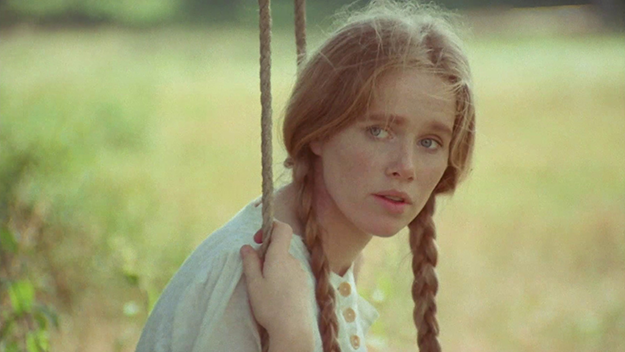
The Emigrants
On the other hand, there are few scenes in movies as uplifting as Karl Oskar’s discovery of his farm at the end of The Emigrants.
I’m sure Moberg added the touch that he marked the tree with his name, K.O. Svensk—that was not my invention. But to finish the film that way—maybe that was my decision. One thing: when he’s walking and getting closer and closer to what he wants, I intercut footage from a Wisconsin forest and lake with similar scenes from the Swedish lake we used for the settlement. When I watched it the other day, I could say exactly “this is from there,” and so on, but it intercuts so well that audiences can’t tell the difference between them. There were several months between some of those shots.
The power of memory is a strong theme and even a visceral component of your movies.
Definitely memories from my childhood and youth are very vivid to me. My daughter Yohanna and I are working on a script about a painter, an artist from Finland, who was born 1862, died in 1946: Helene Schjerfbeck. The working title in English would be The Colors of Longing. And the whole concept is that she’s sitting in a room remembering her life and living in her memory. It’s very germane to what you’re talking about. I’m afraid I am a bit nostalgic. It’s not good to be too nostalgic. The earliest possible time to shoot would be autumn of this year because we have to raise the money and find locations and actors.
I read a few months ago that the director Daniel Espinosa had been hired to remake The Emigrants and The New Land. Do you know anything about it?
I heard about it half a year ago. That director called me and I haven’t heard from him since. As I understood it, he wanted to make a film set in our own time, about a boat of refugees crossing the Mediterranean. And for some reason, he wanted to base it on those books!
Michael Sragow is a contributing editor to FILM COMMENT and writes its Deep Focus column. He is a member of the National Society of Film Critics and the Los Angeles Film Critics Association. He also curates “The Moviegoer” at the Library of America website.







